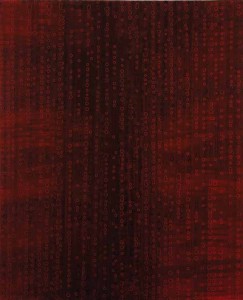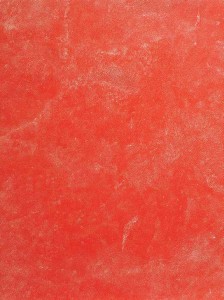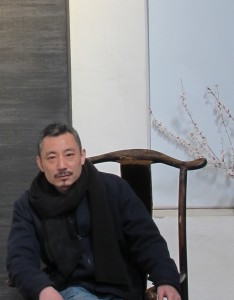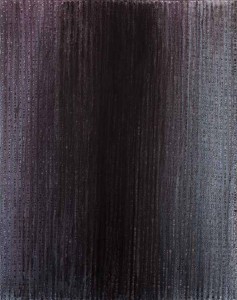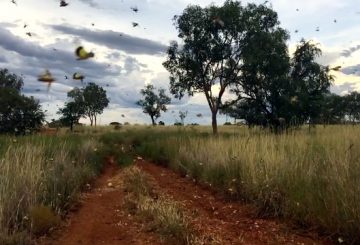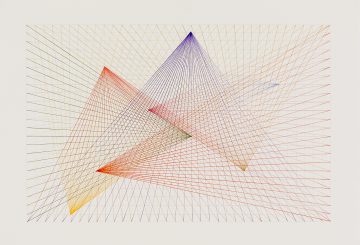Luise Guest encounters a universe in the dots and lines of two very different, but connected artists…
Two worlds, two cultures. The exhibition at Canberra’s Drill Hall presents works by two artists who are utterly different in experience, tradition and intention. And yet, this surprising juxtaposition of works by Chinese painter Hu QInwu and central desert artist Angelina Pwerle creates meaningful connections between the two. Pwerle, an Anmatyerre woman from Utopia in Central Australia whose works centre upon her ‘Bush Plum Dreaming’, and Hu, born in Shandong Province but living and working in Beijing, would initially appear to be utterly unalike, yet they both make works imbued with a sense of wonder and mystery.
Hu Qinwu, ‘11503’, 2011, acrylic on canvas, 110 x 90 cm, image reproduced courtesy of the artist and China Art Projects.
Curator Reg Newitt, of China Art Projects, suggests that the work of these two apparently most disparate artists is connected by “the spiritual and ancestral connection between the now and the past; the relationship of the physicality and spirituality contained within all things”. This same exhibition was shown in Beijing last year, where it was received with great interest.
As you enter the space you are faced with Hu’s “Meditations 1 – 6”, acrylic works on paper which appear to shimmer and float. Deep red pigment is layered over black, with a grid of dots made by dropping water carefully and methodically onto the surface of the work, intended to evoke a text. On one work burn holes made with a soldering iron evoke natural processes of weathering and decay. These particular works appear braille-like, as if they could be read if one only knew how. They suggest a coded language.
Hu’s paintings, such as ‘11503’ feature veils and stains of rich red pigment spread over darker underpainting. The characteristic grid of dots in these works makes them appear weightless, floating, suggesting the rhythmic and regular pulsing of blood in the veins. Together with the ‘Buddhist Volume’ series, in which a fine gold grid overlays Chinese characters which are only partially revealed through the patterning of dots in darker and lighter greys, they make an immersive and immensely quiet experience.
Hu Qinwu’s works are juxtaposed with Pwerle’s, which are all based on her dreaming, and the connections of her ancestor spirits to the land. “We paint our stories from our country,” she says. Her works, also predominantly red and black, evoke drifting clouds, or constellations, and the vastness of the cosmos. They are quite mesmeric. In the words of the artist, they are about “the whole thing”. Like the ‘all-over’ abstract painters of the mid-20th century, both artists create a sense that the worlds they represent cannot be contained by the canvas.
Angelina Pwerle, ‘Bush Plum (28 – 710)’, 2010, acrylic on canvas, 120 x 90.5 cm, image reproduced courtesy of China Art Projects.
I met Hu Qinwu in his Beijing studio last year, and spoke with him about his practice. He showed me his most recent works, in tempera or inks on paper, in which the Chinese characters seem to shimmer, dissolve, disappear and reappear under the patterns of repeated tiny circular forms. They are at once abstract and not abstract, meditative pieces which evoke the colour field works of Mark Rothko in their power to engulf and immerse the viewer. His practice is grounded in his belief in connectedness and simplicity, and in recent works on paper he has used layers of Chinese calligraphy referencing Buddhist sutra scrolls.
Hu Qinwu photographed in his studio, March 2011, photograph Luise Guest.
The dot and the line are the main elements in this calm and ordered body of work. This is painting reduced and distilled – there are no showy gestures or gestural marks. The process is highly controlled and deliberate, and the intention is to pare back the process of painting to its essential elements. Hu tells me the dots can be interpreted as representing text (much like the text in a Buddhist sutra) which resists one single interpretation. They hide layers of calligraphy and subtle washes of colour which are revealed in glimpses across the surface of the work. His work connects back to the ancient scholarly practices of calligraphy and ink painting, which in Hu’s work has become less about the mark of the individual’s brush, and more about the creation of order and simplicity.
It has been said that the process of working the paint is critical, allowing a subconscious state in which the Kong (the Buddhist idea of empty space) can emerge and reveal the continuity and connectedness of life and the universe. Like all artists of his generation in China he has been profoundly affected by the transformation of society in the last twenty years, and the dramatic changes in China’s economy, culture and politics. In his work he attempts to turn inwards and find “a quiet, calm place” to reflect on true and enduring values amidst the confusion of rapid social change. But he also thinks that such chaotic and transitional times are “a pretty good thing for artists”, providing new ideas and opportunities.
Hu Qinwu ‘11506’, 2011, acrylic on canvas, 200 x 160 cm, image reproduced courtesy of China Art Projects.
In a video showing in the gallery space, Angelina Pwerle sits in the desert, delicately and carefully placing miniscule dots onto her canvases, which are weighted down with stones against the elements. The placement of the tiny dots across the surface creates the sacred ‘shimmer’ which gives her work meaning and significance. In the works of Hu QInwu, that deeper meaning is deliberately ambiguous. “Appreciate with your heart not with your eyes,” says the artist. He has created a unique pictorial language which is precisely articulated, yet suggests many possible interpretations.
Hu QInwu likens his painting process to a journey, and in Pwerle’s representations of her bush plum dreaming it is possible to discern the tracks of women across the vastness of the desert landscape. The exhibition itself has travelled from China to Australia, opened here by Mick Dodson. The quietly spoken Hu Qinwu made the journey from his home in Beijing to Canberra, a pilgrimage made by numerous Chinese artists in recent weeks as they arrived for the Biennale and other exhibitions in Sydney, Melbourne and even in Maitland. It would seem that from such cross-cultural and transnational artistic ‘conversations’ new possibilities for artists can emerge. And that can only be a good thing.
E(merge):Two Spiritualities – Angeline Pwerle and Hu Qinwu,
Drill Hall Gallery, Australian National University, Canberra, until August 12
